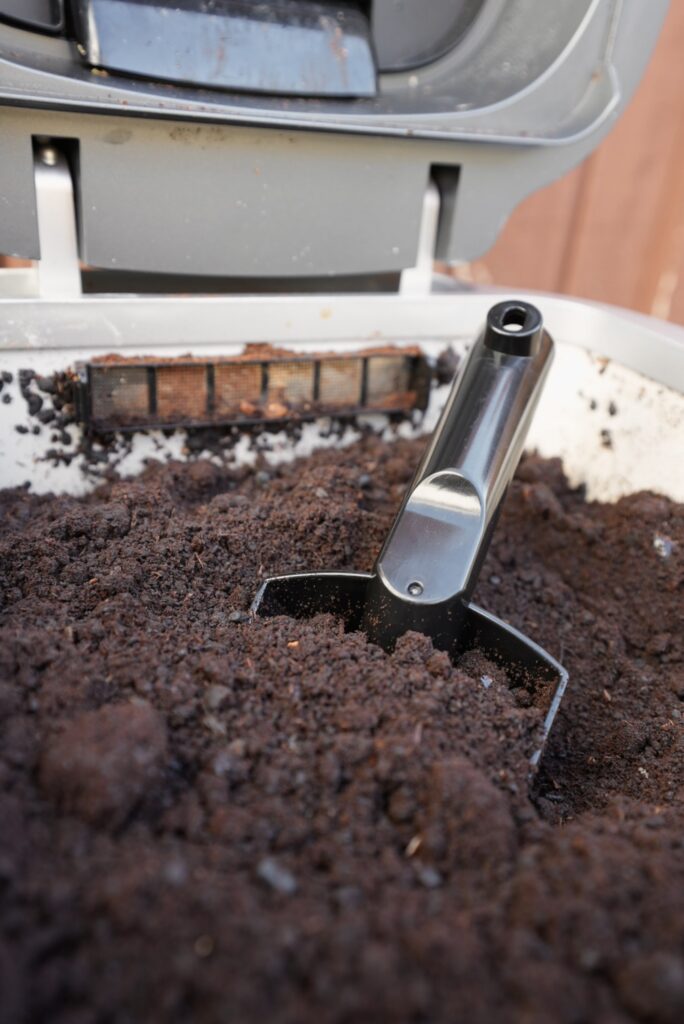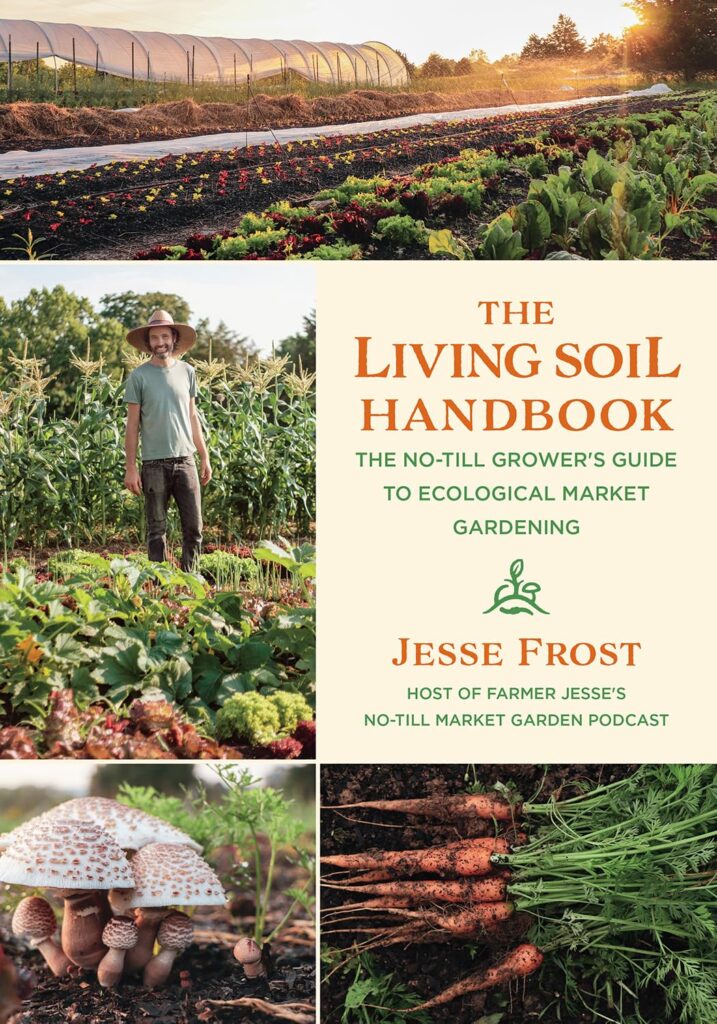Hi everyone! Real Farmer Jeff here!
I’m excited to walk you through the 4 main reasons why I love our Reencle Indoor Composter, and how it has helped us in our goal to harvest as many vegetables as possible from our small townhouse garden.
Healthy soil is vital to maximizing our harvest, and compost is an important component of healthy soil. I would even say that soil health is the most important long-term factor to create sustainable high yields.
The Reencle Indoor Composter has brought Kyrié’s cooking and my gardening full circle. Her cooking creates food scraps that generate new compost, which then allows me to grow more vegetables for her to use in even more recipes.
My goal for next year is to help her grow the widest possible variety of the freshest and most nutrient-dense produce for her recipes.
Below you can read how I became inspired to curate healthy soil in my garden by using homemade compost, as well as the 4 reasons I would recommend the Reencle Indoor Composter.


TABLE OF CONTENTS
Learning About Compost:
- Microbe-Rich Compost
- No Food Grinding & Dehydration
- Speed & Space Efficiency
- The Regenerative & Sustainable Food Cycle
- Bonus: Other Advantages
Resources to Learn About Healthy Soil:
To start us off, I’ve thrown in the following photos:
- Before & mid-season shot of our garden
- Me (Farmer Jeff, to put a face to the name) and Kyrié on our wedding day (at a farm, of course)
- Tomatoes we harvested from our garden




What is Healthy Soil?
A vital part of most thriving gardens is using compost and mulch to create a living soil in which microbes and plant roots can exchange nutrients. Our goal as a gardener should not be to feed the plants directly, but rather to feed the microbial populations in the soil. I learned this from Jesse Frost, author of The Living Soil Handbook, which I’ll discuss further below as an excellent resource for understanding healthy soil.
Healthy soil not only contains the right profile of macro and micronutrients, but also benefits from a biodiversity of microbes and organisms that naturally fight disease and pest pressure. When I think of creating a healthy soil, I think of forming a healthy gut biome to have good digestion.
Specifically, healthy soil has the benefit of being protected against three main environmental threats that hurt short-term yields and long-term sustainability:
Compaction: Tightly pressed soil particles reduce pore space, affecting plant growth, surface water runoff, and organism health.
Erosion: Wind or rain leads to drought, affecting soil’s ability to hold nutrients and water.
Dehydration: Intense heat or sunlight dries out organic matter, impacting soil drainage, water retention, and habitat for microbes and organisms.

Why Use Compost?
Utilizing compost, which is decomposed organic material, is crucial to soil health because it mimics the natural process that can be observed in any healthy ecosystem. While all compost should have a ratio of at least 10 parts carbon to 1 part nitrogen to not be considered manure or rotting organic matter, there are still a wide range of compost varieties.
Some composts are fine, concentrated mixtures that are best for fertilizing soil with nutrients or inoculating soil with a diverse microbiology. In contrast, other types of compost are less refined and are better used as mulches or as growing mediums. It is extremely hard to buy high-quality compost and utilize it correctly because of how broadly compost is defined.
Additionally, poor quality compost that you find commercially is often less rich in nutrients or microbes and may even have herbicides or other harmful chemicals present.
Due to these complications, many gardeners prefer to make their own compost.

The 4 Reasons I Recommend the Reencle Indoor Composter
I’ve used the Reencle Indoor Composter for the whole 2024 gardening season and have been extremely impressed in nearly every way. In fact, I strongly feel that the Reencle Indoor Composter is the best indoor composter on the market by a wide margin!
My garden has benefited from adding fresh compost made from our food scraps and I would highly recommend the unit to any of my friends who are either serious about gardening or mindful of their food waste and personal sustainability.
1. Microbe-Rich Compost
The main reason that the Reencle Indoor Composter stands alone is because it is literally the only indoor, home composter on the market that I know of which creates true, microbe-rich compost.
The Reenclemicrobe™ compost starter has a patented microbe technology that breaks down food scraps by using Bacillus bacteria. Once you activate the starter, you should never need to replace the microbes if you follow the recommendation to only add 2.2 pounds or less of food scraps per day.
When it comes time to harvest the compost, you should leave about ⅓ of it, to assure that enough microbes remain to continue the self-perpetuating composting process.
2. No Food Grinding or Dehydration
After doing my own personal research, I found that other main indoor composters grind and dehydrate food scraps at high temperatures, often over 200°F, compared to ~140°F for the Reencle Indoor Composter.
Because they sterilize food with high heat, these compost mixtures do not have a comparable micro diversity. This can also lead to high sodium levels from the dehydration process, which can be problematic for gardening.
Dehydrated food scraps could be used as a kind of mulch in the garden, but that type of compost is not ideal for infusing soil with nutrients like a fertilizing compost would be.
For me, the most exciting thing about making compost from my food scraps is knowing exactly what nutrients I will be returning to the soil, which is why I would want to make a “true” microbe-rich compost that I could infuse into the soil.
This way, I can treat my garden like a pampered dog and feed it the best diet possible.

3. Speed & Space Efficiency
It is astounding how fast the Reencle Indoor Composter works through its heating, churning, and active microbe technology. 90% of food waste can generally be broken down in 24 hours, which is weeks to months quicker than what would naturally be possible outdoors.
You can also compost animal products with no issue unlike garden tumblers that require using plant-based materials.
If you are like me and you live in a townhome, apartment, or really any sized space a Reencle Indoor Composter is ideal for its compact size. You hardly need any space at all to create compost, which is especially great for those who either can’t or don’t want to dedicate large parts of their home or yard to composting.
Does the Reencle Indoor Composter smell?
This is one of the most common questions I get from people. The smell isn’t very noticeable unless you were to directly stick your face over the open unit. I personally wouldn’t consider it a bad smell just like dirt has its own smell that most people would not say is bad. Low odor is a significant feature because traditional outdoor composting is often so smelly that it deters many people from creating their own.

4. The Regenerative and Sustainable Food Cycle
Like I mentioned, it’s been so fun to bring Kyrié’s cooking and my gardening full circle. Even though we have always tried to be conscious of our food waste, we still unfortunately generate loads of food scraps either from our produce or leftovers going bad.
Now, because we compost, this has shifted our feelings of guilt over wasted food scraps into excitement about creating nutrient-rich compost for our garden.
The Reencle Indoor Composter can break down essentially anything from fruits and vegetables to animal products such as meat or dairy. It also thrives with cooked items such as baked goods or kitchen leftovers. The only thing it’s important to avoid adding are bones, shells, and pits.
I love knowing that my family’s food scraps are being utilized well, and are not creating methane gas in landfills, which is not good for the environment.

Bonus: Other Advantages
The Reencle Indoor Composter also has the following advantages:
- Supreme odor control with multiple filters–seriously, you can’t smell it!
- Many competitors only have one filter, while the Reencle Indoor Composter has multiple.
- You can compost stinky items such as fish (that would be very smelly and problematic to dispose of in a trash can) with ease.
- Extremely quiet compared to competitors (I’ve never noticed its noise), and seems much quieter than other appliances such as our refrigerator.
- The filter only costs about $25 per year, which is a fraction of the cost of competing brands, which can cost several hundred dollars per year.
- Lower energy usage, and therefore cheaper than other brands.
- Pairs extremely well with our trash can. We put them next to each other and can easily separate our food scraps from non-compostable trash
- We love the automatic lid that shuts.
- Because of how food breaks down and reduces before harvest, the Reencle Indoor Composter seems to have an even larger capacity than a large trash can.
Get yourself a Reencle Indoor Composter, or get one for a loved one. It could make the perfect birthday or holiday gift for a gardener, eco-conscious friend, or culinary enthusiast!

The Biggest Little Farm Documentary
I first became captivated by the idea of creating healthy soil when I watched a documentary called The Biggest Little Farm. I would recommend watching it to anyone because it is so heartwarming and entertaining, yet informative.
The documentary tells the true story of a couple who bought a barren, abandoned 200-acre orchard near Los Angeles and turned it into a thriving ecosystem and profitable farm over the next eight years. Step one of this transformation was improving the soil health by planting cover crops that eventually increased water retention, reduced erosion, and developed a healthy topsoil full of microbes.
This documentary inspired me to create a balanced ecosystem in my own garden and highlighted that soil health should be my top priority. You should really check out the documentary! It’s available on Amazon Prime here and I’ve linked the trailer below.
The Living Soil Handbook
After becoming inspired about soil health, I bought a book called The Living Soil Handbook by Jesse Frost to continue learning.
Jesse Frost is a master of a technique called “no-till gardening” that aims to achieve maximum soil health by disturbing the soil as little as possible through always keeping the soil covered or planted. This technique generates high yields while being very sustainable and good for the environment.
In contrast, mass-farming techniques generally rely on heavily tilling the soil and adding large amounts of fertilizer to achieve productive short-term harvests that sadly degrade the soil and harm the environment long-term.
No-till gardening is such a productive technique that Jesse actually operates a six-figure “market garden” where he farms a normal residential plot of land (less than 1 acre) as his full-time job. Market gardens fascinate me because of how they bridge the gardening and farming communities, and because of their sustainable high yields. They are also often located in the suburbs and contribute to local farmers’ markets, which I think is so cool.













Great article! Thanks for all of this information. I am interested to watch that movie now.
It’s great to hear too that it isn’t smelly. So cool that you can feed your own garden starting in your kitchen!
I actually watched that movie at the Sundance Film Festival several years ago and was surprised Jeff had seen it! It is life changing! So fun having Jeff plant so much for us 🙂
I’m honestly amazed how quickly the Reencle breaks down food scraps. I live in an apartment and really want to get one.
Super helpful to see what worked and what didn’t. Thanks for the review!